5 Cat Flea Shampoo Secrets That Will Astound You
If you’re a concerned pet owner, you know how bad fleas can be. These parasites create significant irritation and anxiety for your feline friend. Finding the right flea treatment is key.
Choosing a flea shampoo for your pet can be tough. You want something that works well and is safe for your furry friend. Knowing some critical facts can help you make a good choice.
In this article, we’ll share five shocking truths about cat flea shampoo. These facts will help you protect your pet from fleas. This way, you can keep your pet happy and healthy.
Table of Contents
The Hidden World of Cat Flea Infestations

Understanding cat flea infestations is key to your cat’s health and happiness. Fleas are more than a bother; they can cause serious health problems for your cat.
How Fleas Impact Your Cat’s Health
Fleas suck your cat’s blood, causing discomfort and allergic reactions. Their saliva can trigger severe allergic reactions, leading to intense itching and skin infections. They can also spread tapeworms and other parasites.
The Lifecycle of Fleas and Why It Matters
The flea lifecycle consists of four distinct phases: egg, larval, pupal, and adult stages. Knowing this lifecycle is vital for controlling fleas. Egg and larval stages often occur in your home environment, while adult fleas live on your cat.
Eggs and Larvae in Your Home
Flea eggs and larvae hide in carpets, bedding, and places your cat likes. These stages are crucial for the flea lifecycle. If not treated, they can hatch into adult fleas.
Adult Fleas on Your Cat
Mature fleas represent the most noticeable phase and reside directly on your feline. They feed on blood and cause discomfort. Applying cat flea shampoo effectively eliminates mature flea populations. However, addressing the immature stages within your household environment remains equally crucial.
To manage flea infestations well, treat both your cat and the environment. This approach breaks the flea lifecycle and stops re-infestation.
Shocking Truth #1: Most Cat Flea Shampoos Contain Potentially Harmful Chemicals
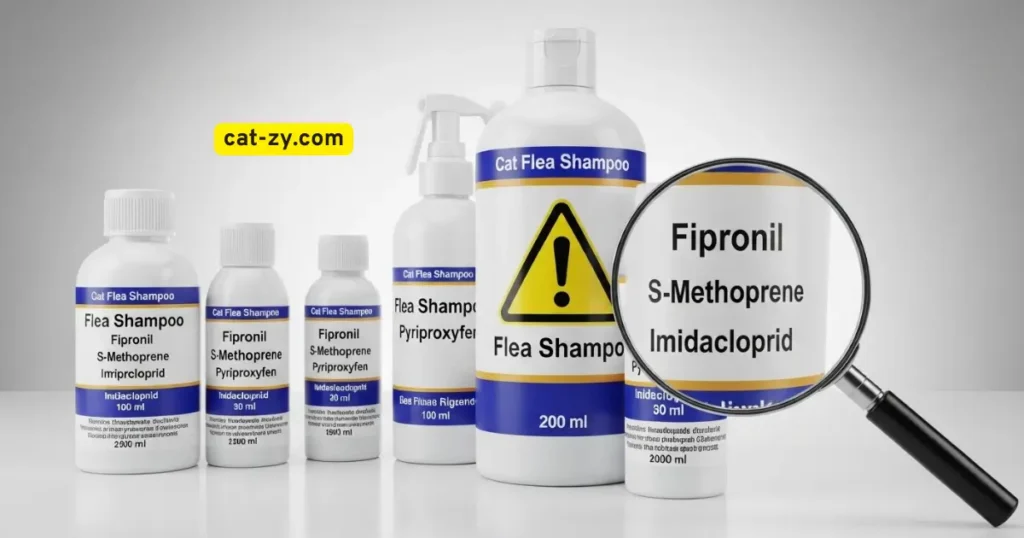
Many cat owners don’t know that cat flea shampoo might harm their pets. These products aim to get rid of fleas but can cause new issues.
Common Toxic Ingredients to Watch For
Some cat flea shampoos have chemicals that can harm your pet. Knowing these ingredients is key to keeping your cat safe.
Pyrethrins and Pyrethroids
Pyrethrins and pyrethroids are found in many flea shampoos. They’re usually safe, but can be bad for cats if they’re sensitive or swallow them.
Organophosphates and Their Risks
Organophosphates are in some flea products. They can harm your cat’s brain and are seen as toxic by vets.
Long-term Health Risks for Your Cat
The chemicals in cat flea shampoo can harm your cat over time. Knowing these risks helps you make better choices.
Neurological Concerns
Some ingredients can mess with your cat’s nervous system. This might lead to shaking, seizures, or other brain problems.
Skin and Respiratory Issues
Other cats might get skin problems or breathing issues from flea shampoo chemicals.
Shocking Truth #2: Many Cat Flea Shampoos Only Address Part of the Problem
Many cat flea shampoos only solve part of the flea problem. This leaves your cat open to getting fleas again. When you use a flea shampoo, remember it doesn’t just kill adult fleas on your cat’s body.
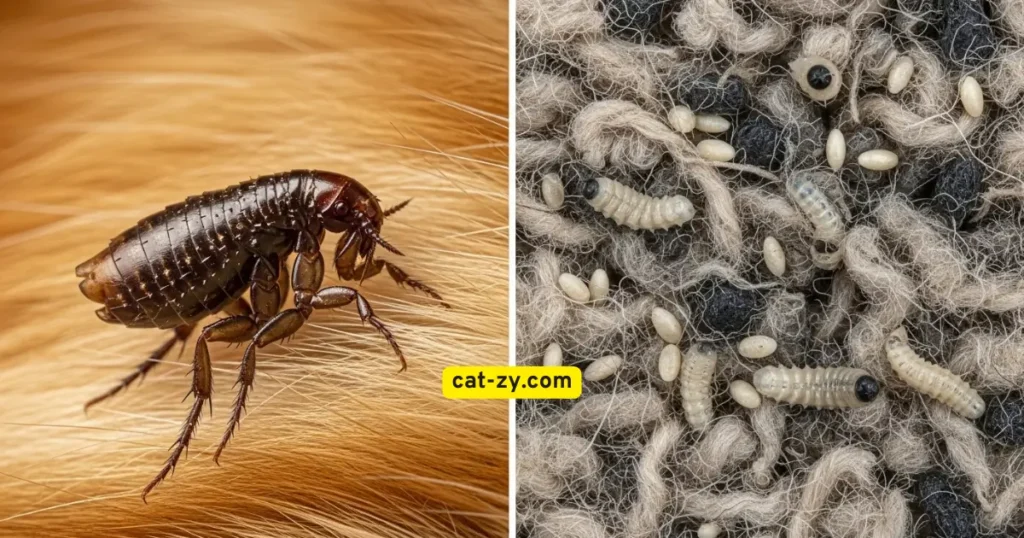
Why Killing Adult Fleas Isn’t Enough
Killing adult fleas is important, but it’s just the start. Flea infestations include eggs, larvae, and pupae, too. Ignoring these stages can quickly lead to reinfestation, making it seem like the shampoo failed.
The Importance of Breaking the Flea Life Cycle
To really manage fleas, you must break their life cycle. This means killing adult fleas and also eggs, larvae, and pupae. These eggs may remain inactive throughout your residence for extended periods, prepared to emerge and restart the infestation process.
Eggs That Remain in Your Home
Flea eggs hide in your cat’s bedding, carpets, and where your cat likes to hang out. These eggs are hard to get rid of and need more than just shampoo. Thorough cleaning and treatments for your environment are key to killing these eggs.
Reinfestation Cycles
If you don’t stop the flea life cycle, reinfestations will keep happening. New fleas will hatch, grow, and start the cycle over. This puts your cat through the discomfort and health risks of fleas. Consistent and complete flea control is essential to stop this cycle.
Shocking Truth #3: Natural Cat Flea Shampoo Alternatives May Be Less Effective
Natural cat flea shampoos are becoming more popular. But are they as good as chemical-based options? It’s important to know the differences between these two types of flea control.
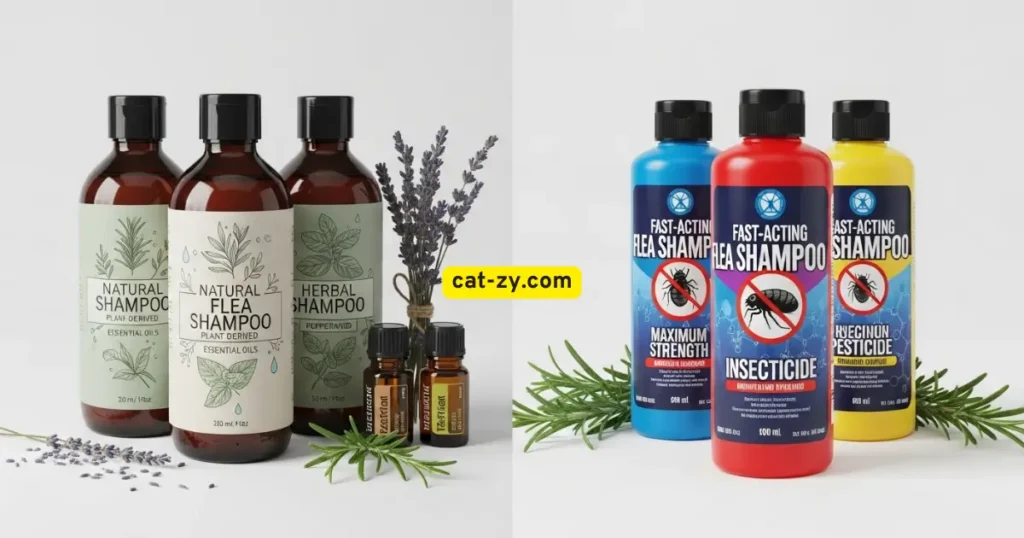
The Science Behind Natural vs. Chemical Treatments
Chemical cat flea shampoos use ingredients like permethrin or pyrethrin. These are fast at killing fleas. Natural shampoos, on the other hand, use essential oils, plant extracts, or diatomaceous earth. While natural ingredients can work, they might not kill fleas as fast or as well as chemicals.
When Natural Options Work Best
Natural cat flea shampoos are good in some cases. They’re great for cats with sensitivities or allergies to chemicals.
Mild Infestations
For mild flea problems, natural shampoos can be a good choice. These alternatives effectively reduce parasite populations while avoiding aggressive chemical compounds.
Preventative Care
Using natural shampoos regularly can prevent fleas. This is good for cats that go outside a lot.
When picking between natural and chemical shampoos, think about your cat’s needs. Look at the infestation’s severity and any allergies. Making the right choice helps manage fleas and keeps your cat healthy and happy.
Shocking Truth #4: Improper Use of Cat Flea Shampoo Can Be Dangerous
Many cat owners don’t know that using cat flea shampoo wrong can harm their pets. Cat flea shampoo serves the purpose of eliminating fleas and other external parasites. But using it the wrong way can cause big problems.
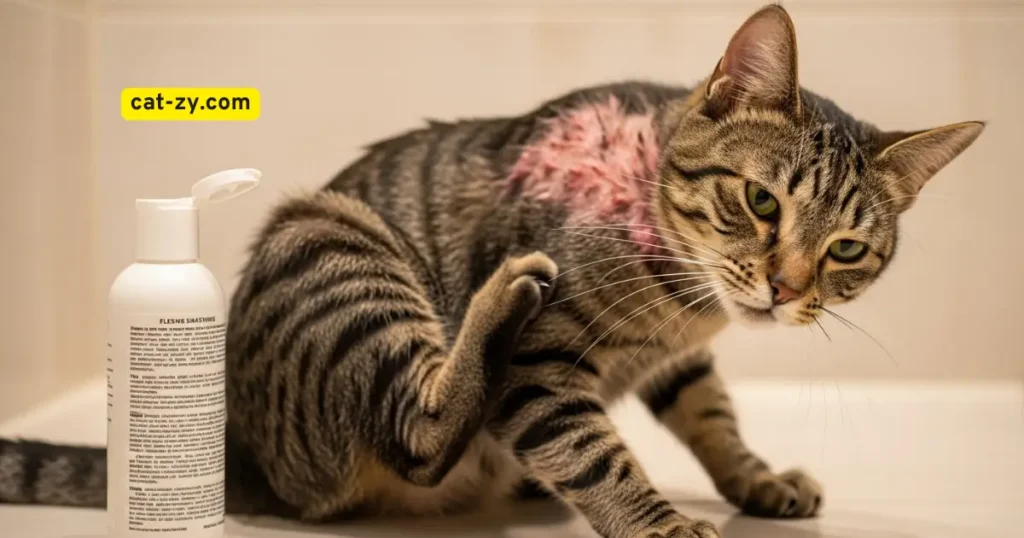
Common Application Mistakes
One big mistake is not reading the shampoo instructions. This can lead to using too much or not rinsing enough. Both can be bad for your cat.
Incorrect Dilution
Using the wrong amount of shampoo can make it too weak or too strong. If it’s too weak, it won’t kill fleas. If it’s too strong, it can hurt your cat’s skin.
Inadequate Rinsing
Not rinsing well enough can leave shampoo on your cat’s fur. This can cause skin irritation or allergic reactions.
Signs Your Cat Is Having an Adverse Reaction
Watch your cat closely after using flea shampoo for any bad reactions. These can happen right away or later.
Immediate Warning Signs
Look out for signs like too much scratching, redness, or swelling. If you see these, wash your cat well and talk to a vet.
Delayed Reactions to Watch For
Later, you might see skin problems, hair loss, or changes in behavior. If you notice these, see a vet to figure out what to do.
Knowing the dangers and using flea shampoo right can keep your cat safe. It also helps manage flea problems well.
Shocking Truth #5: Cat Flea Shampoo Alone Is Rarely a Complete Solution
When dealing with fleas, using cat flea shampoo is just the start. It gives quick relief but isn’t enough for lasting results. You need a full plan to win the fight against fleas.
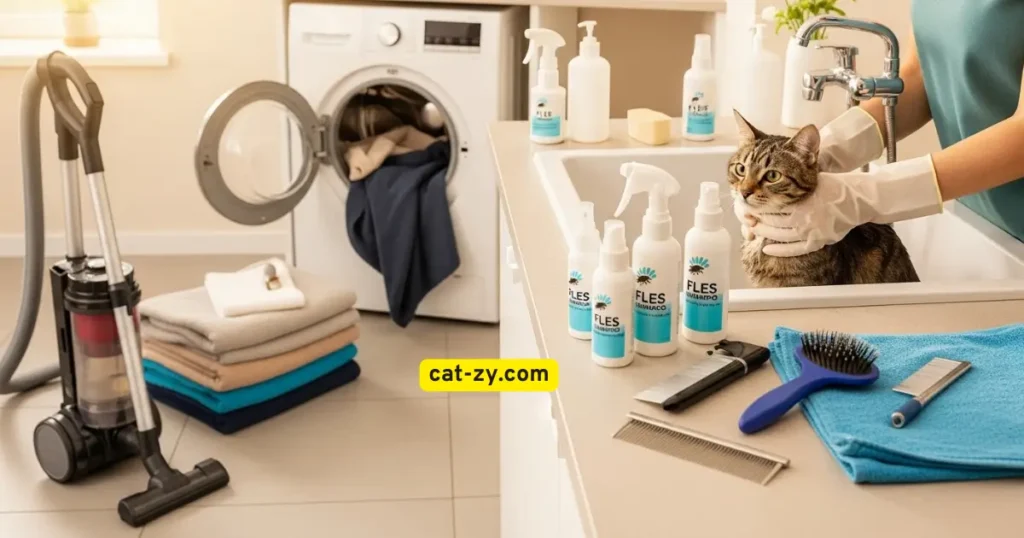
Why a Multi-Pronged Approach Is Necessary
Fleas are tough to beat because they go through many stages. Cat flea shampoo might kill the adult fleas on your cat. But it misses the eggs, larvae, and pupae hiding in your home.
Complementary Treatments for Effective Flea Control
Achieving comprehensive flea management requires addressing both your pet and the surrounding environment. This means:
Home Environment Treatment
Vacuuming your home often, where your cat likes to hang out, can cut down flea numbers. Also, wash your cat’s bedding in hot water and dry it on high to kill fleas and their eggs.
Ongoing Prevention Methods
Don’t stop at treating your home. Use flea prevention on your cat, like topical treatments or pills. Regular grooming and checks can catch flea problems early.
With a multi-pronged approach that includes cat flea shampoo, home treatment, and prevention, you can keep fleas away. Your cat will thank you for it.
How to Choose the Right Cat Flea Shampoo for Your Pet
Choosing the right cat flea shampoo can be tricky with so many options. It’s important to know what your cat needs and what to look for. This will help you make a good choice.
Factors to Consider Based on Your Cat’s Age and Health
Your cat’s age, health, and lifestyle are key when picking a flea shampoo. Kittens, pregnant or nursing cats, and cats with health issues need special care. Always check the label to make sure the shampoo is safe for your cat.
Some shampoos aren’t good for kittens or cats with allergies. It’s crucial to avoid these for your cat’s safety.
Decoding Product Labels and Ingredients
It’s important to know what’s in the flea shampoo. Seek formulations that clearly specify their active components and concentrations. Ingredients like permethrin, pyrethrin, and fipronil are effective against fleas.
But some cats might be sensitive to these. Also, check for extra ingredients that help soothe and protect your cat’s skin.
Veterinarian-Recommended Options
Vets often suggest flea shampoos based on their safety and effectiveness. There are prescription-strength and over-the-counter options, each with its own benefits.
Prescription Strength Products
Prescription-strength shampoos are stronger and recommended for severe flea problems. They are available only through a vet and can be more effective for cats with a lot of fleas.
Over-the-Counter Solutions
OTC flea shampoos work well for mild to moderate flea issues. They are easy to find and good for regular use. When picking an OTC product, look for positive reviews from other pet owners and vets.
By considering your cat’s needs, reading labels, and talking to your vet, you can find the best flea shampoo. This will keep your pet happy and flea-free.
Step-by-Step Guide to Using Cat Flea Shampoo Effectively
To get the best results from cat flea shampoo, follow a step-by-step guide. The right techniques ensure the product works well and keep your cat safe and comfortable during bath time.
Before the Bath: Preparation Tips
Before using cat flea shampoo, get your cat and the bath area ready. Brush your cat to remove tangles and mats. This makes applying the shampoo easier. Make sure the bathing area is safe and free from distractions.
Gather all needed supplies, like towels, shampoo, and a non-slip mat for the bathtub or sink.
During the Bath: Application Techniques
Start by wetting your cat’s coat well. Then, apply the shampoo as the product’s instructions say. Avoid sensitive areas like the eyes, ears, and nose. Gently massage the shampoo into your cat’s coat, making sure it gets to the skin where fleas live.
After the Bath: Follow-up Care
After rinsing your cat well, take care of them next. Post-bath care involves thorough drying and monitoring for potential adverse reactions.
Drying Your Cat Properly
Softly blot your feline’s coat using a towel while avoiding excessive friction. This can irritate their skin. If your cat can handle it, use a blow dryer on a low setting to dry their coat further, which is good in colder climates.
Monitoring for Side Effects
Watch your cat closely after using cat flea shampoo for any bad reactions. Look for signs like excessive scratching, redness, or being very tired. If you see these symptoms, talk to your vet for advice.
By following these steps and using cat flea shampoo as directed, you can manage flea infestations on your cat. This ensures their comfort and health.
Preventative Measures: Stopping Flea Infestations Before They Start
You can keep your cat safe from fleas by taking preventive measures. Keeping up with regular care and staying alert can stop fleas before they start.
Regular Grooming and Inspection Routines
Regular grooming is key to finding fleas early. Use a fine-tooth comb to check your cat’s coat, focusing on the neck, tail, and belly. Regular checks can catch flea problems early.
Year-Round Prevention Strategies
It’s important to prevent fleas all year. Incorporate cat flea shampoo within a comprehensive parasite management strategy. Also, consider topical treatments or oral meds to stop fleas.
Seasonal Considerations
Fleas are more common in warmer months, but they can happen any time, even in heated homes. Change your prevention plan with the seasons, being more careful during flea peak times.
Multi-Pet Household Approaches
If you have more than one pet, treat them all at once to avoid re-infestation. Use a complete plan that includes grooming, treating the environment, and meds for all pets.
By following these steps, you can lower the chance of flea problems. Such measures create a more comfortable living environment for your feline companion.
Other Flea Management Options for Bath-Averse Felines
Not all cats like baths, so finding other ways to fight fleas is key. If your cat doesn’t like baths, there are other ways to keep fleas away. You don’t have to use cat flea shampoo baths.
Topical Treatments and Their Effectiveness
Topical treatments are a good alternative to baths. They are applied to the cat’s skin, usually between the shoulder blades. They offer long-lasting protection against fleas.
Oral Medications and Preventatives
Oral medications are another effective option. Products like Capstar and Comfortis are given orally. They work systemically to kill fleas.
These are great for cats with severe flea problems or those hard to treat topically.
Environmental Control Strategies
Controlling fleas also means cleaning your home. Regular vacuuming and washing your cat’s bedding are important. Using environmental sprays or foggers can also help get rid of fleas and their eggs.
Conclusion: Making Informed Decisions About Cat Flea Control
Managing flea infestations on your cat is more than just using flea shampoo. You need to understand flea life cycles and the risks of certain ingredients. This knowledge helps you protect your pet’s health.
When picking a flea shampoo, think about your cat’s age, health, and lifestyle. Choose products with safe, effective ingredients. Also, be cautious of possible adverse reactions. Use shampoo with other methods like regular grooming and controlling the environment for the best results.
Maintaining a preventive approach with proper knowledge ensures your feline’s well-being and comfort. Whether you choose traditional shampoo or alternative methods, stay alert. Adjust your strategy as needed to keep your cat flea-free.
FAQ
Which cat flea shampoo works most effectively for my feline?
Selecting an appropriate cat flea shampoo involves considering several important factors. Consider your cat’s age, health, and how bad the flea problem is. Select a formula specifically designed for felines containing safe yet potent components.
What frequency is recommended for cat flea shampoo treatments?
How often to bathe your cat with flea shampoo varies. It depends on the product’s instructions and how bad the flea problem is. Usually, bathe every 7-10 days, but always follow the product label.
Is it safe to apply canine flea shampoo to my feline?
Absolutely not – canine flea products should never be applied to cats. Dog shampoos can be toxic to cats. Always use a shampoo made for cats.
What signs indicate my feline is experiencing negative effects from cat flea shampoo?
Look for signs like too much scratching, red skin, or vomiting. If you see these, rinse your cat well and talk to your vet.
Can I use cat flea shampoo on pregnant or nursing cats?
It’s best not to use flea shampoo on pregnant or nursing cats. Some ingredients can harm the developing babies or kittens. Always ask your vet for safe flea control options.
How can I prevent reinfestation after using cat flea shampoo?
To stop fleas from coming back, treat your home. Wash your cat’s bedding, vacuum, and use flea prevention on your cat. Also, treat other pets in your home.
Are natural cat flea shampoos effective?
Natural flea shampoos can work for mild cases or as part of regular care. But, they might not be as strong as chemical shampoos for serious problems.
Can I use cat flea shampoo on kittens?
Some flea shampoos are okay for kittens, but check the label for age and weight limits. Always talk to your vet for the safest flea control for kittens.
Can you use cat flea shampoo on dogs?
No, never use cat flea shampoo on dogs. Cat-specific formulations contain different ingredient concentrations that may be ineffective or potentially harmful for canines. Dogs require specially formulated flea shampoos designed for their unique skin pH and sensitivity levels. Always choose species-specific products to ensure safety and effectiveness.
Can humans use cat flea shampoo?
Cat flea shampoo should never be used on humans. These products contain pesticides and chemicals specifically formulated for feline skin and metabolism, which can cause severe allergic reactions, skin irritation, or toxicity in humans. If you have flea concerns, consult a healthcare provider for appropriate human-safe treatments.
Can you use cat flea shampoo on ferrets?
Cat flea shampoo should not be used on ferrets without veterinary consultation. Ferrets have extremely sensitive skin and unique metabolisms that process chemicals differently from cats. Many ingredients safe for cats can be toxic to ferrets. Always use ferret-specific flea treatments or consult an exotic veterinarian for safe alternatives.
Can I wash my dog with cat flea shampoo?
Absolutely avoid washing your dog with cat flea shampoo. The chemical concentrations and active ingredients in cat formulations can be inappropriate or dangerous for dogs. Dog skin has different pH levels and absorption rates. Use only dog-specific flea shampoos to prevent adverse reactions and ensure effective flea elimination.

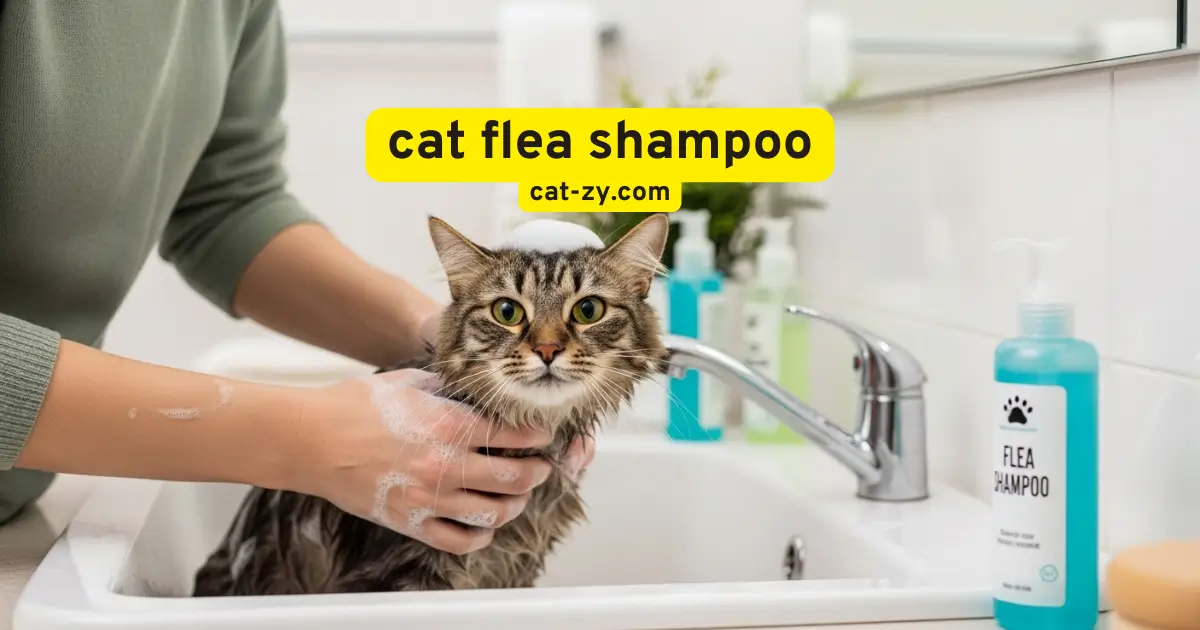
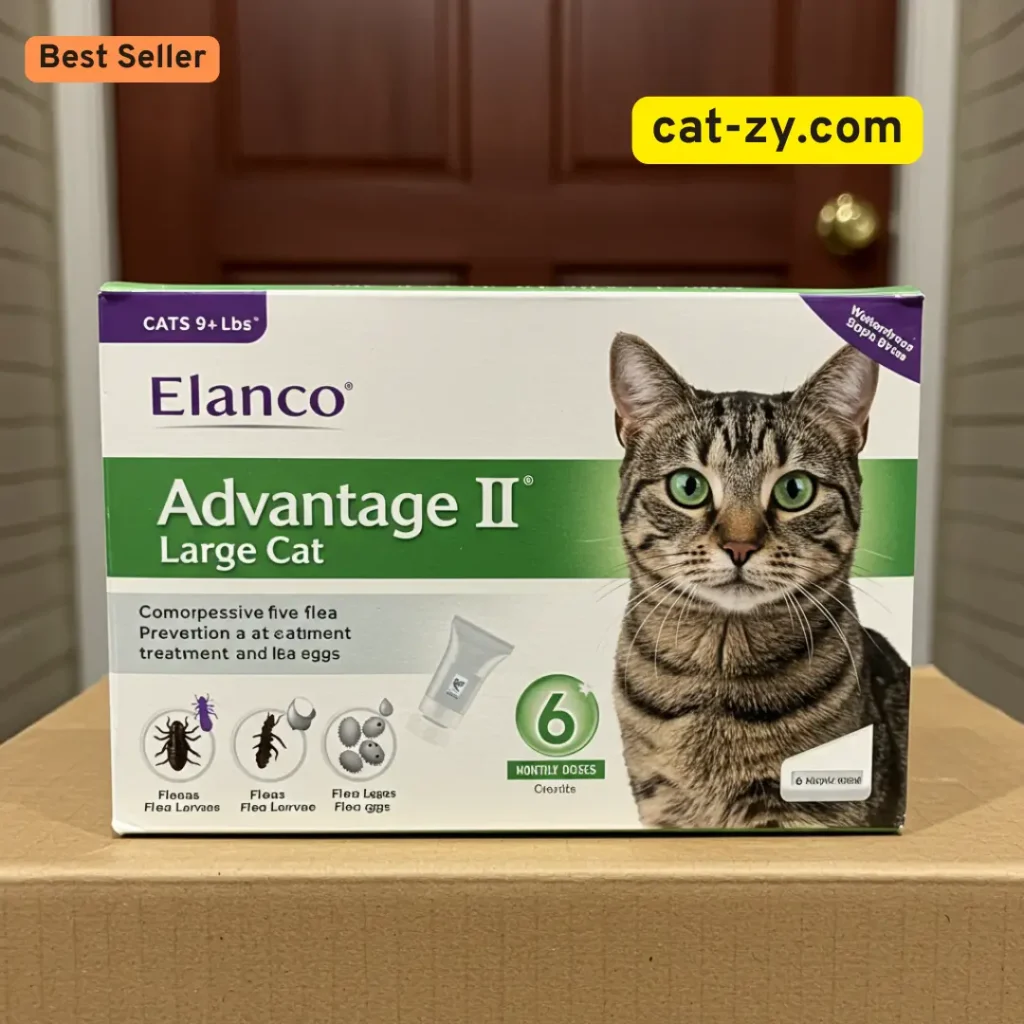
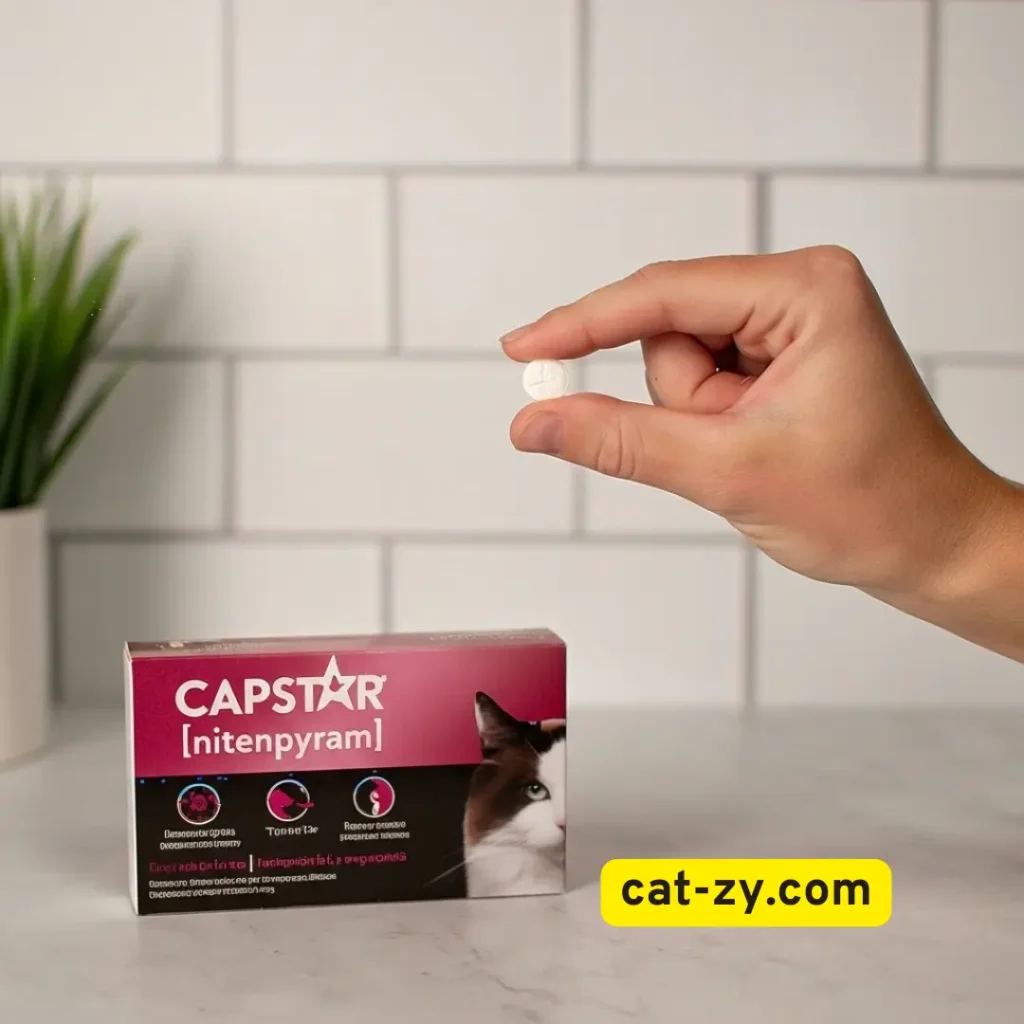


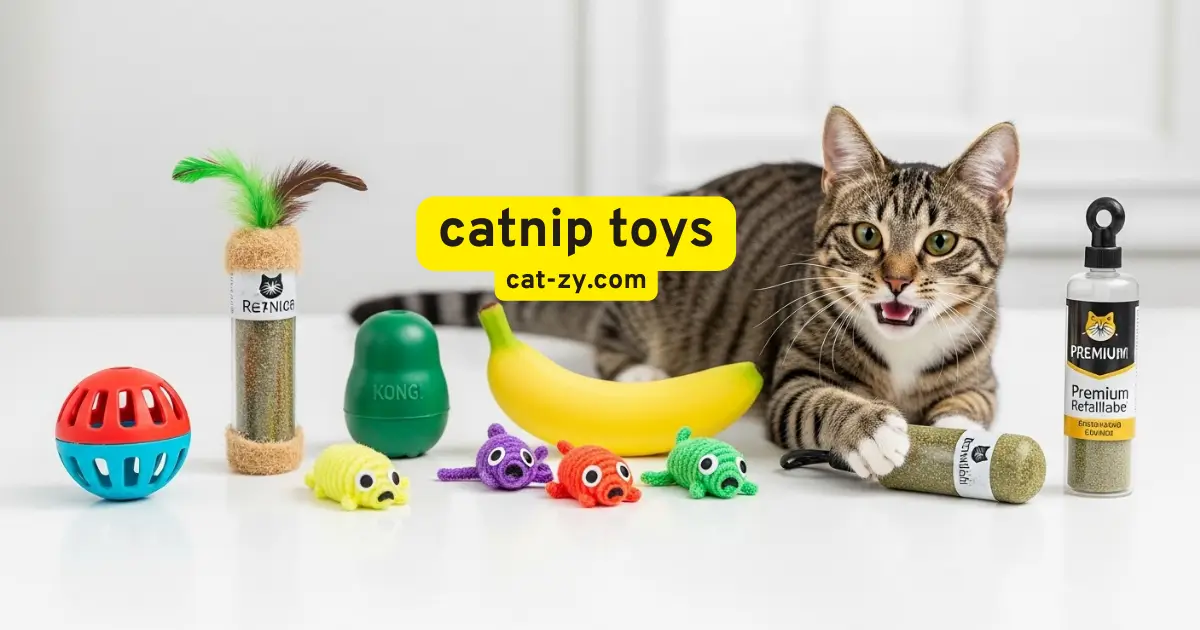


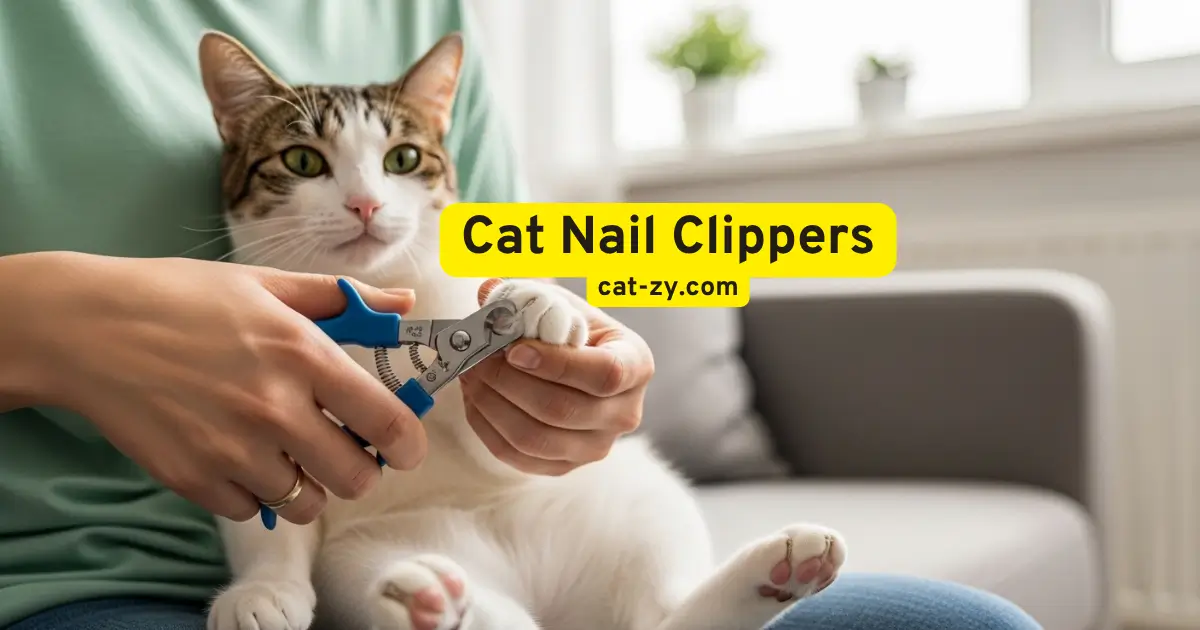
One Comment
Comments are closed.